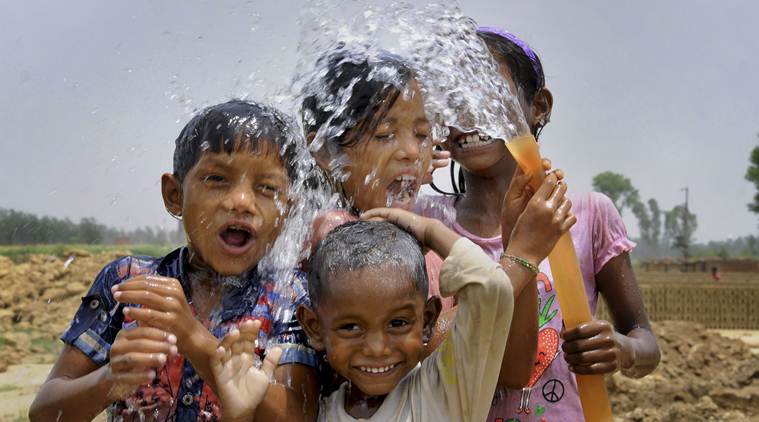- India
- International
Brimming reservoirs gush to Pakistan, but not to taps in parched Punjab
Barring 30-40 per cent of this water being used in the state for irrigating the summer crops, the remaining drained out to Pakistan and other Indian states, including Rajasthan, through the canal network.
 Children cool themselves with a water-pipe to get respite from the scorching heat, in Amritsar, Wednesday. (PTI Photo)
Children cool themselves with a water-pipe to get respite from the scorching heat, in Amritsar, Wednesday. (PTI Photo)
In around one and half months, beginning April-end to June 12, around 2,060 million cubic metres (MCM) water was released from three dam reservoirs built over three major rivers of Punjab — Bhakra dam on Sutlej, Pong dam on Beas and Ranjit Sagar dam on Ravi. And barring 30-40 per cent of this water being used in the state for irrigating the summer crops, the remaining drained out to Pakistan and other Indian states, including Rajasthan, through the canal network.
While on the face of it these figures from the Central Water Commission (CWC) back the state government’s argument of releasing excess water downstream to prevent flooding during monsoons in Punjab, they also underline the state’s failure to utilise a readily available resource to meet supply gap in urban areas and to recharge a fast depleting ground water table.
Amid a raging controversy over the flow of excess water from Punjab’s rivers to Pakistan, a senior officer at Bhakhra dam said: “It is better to give water to Pakistan instead creating flood-like situation in Punjab during the monsoon.”
Another official added: “All the water is released as per the consent of the officials from Punjab, Haryana, Rajasthan.”
Asked if this water could have been used in the Punjab and Haryana to supply to the urban areas during summers and for recharging the ground water, the officer added that it was the responsibility of the state government to make required reservoirs and plans for this purpose.

Also read | For Haryana, Punjab, last fortnight one of the driest periods since January
The Joint Director of Punjab Agriculture Hydrology-Geology Wing, Rajesh Vashist, agreed that river water can be used for recharging of water table and supplying water to urban areas, but added that for this proper studies for filtration are needed.
Currently, about half a dozen major cities of Punjab require nearly 3000 MLD (Million Litre a Day) water daily, including nearly 400 MLD in Jalandhar.
In Jalandhar, for instance, the Municipal Corporation (JMC) had considered a plan two years back for bringing Beas river water to the city, which is under dark zone, through pipelines. The project would have cost Rs 2000 crore. “Around 250 cusecs water will quench the thirst of entire Jalandhar city,” said Superintendent Engineer, Water Supply, Punjab, adding that no extracting of ground water for few years would have automatically recharged the ground water table here.
In Punjab, out of 141 agricultural blocks, 109 blocks have already fallen under the dark Zone. A senior officer in the Canal and Irrigation Department, Punjab, said that regular release of water in canals can recharge the water table, but due to improper maintenance of canals, water is released only for some months in several canals across the state.
About the past one month, an official at the Bhakra Beas Management Board (BBMB) said that nearly 10,000 to 15,000 cusecs water went to Pakistan flowing downstream as there was less demand from Rajasthan due to some repair work in canal. PEP leader Sukhpal Khaira had Wednesday alleged that around 15,000 to 20,000 cusecs water was released from Punjab’s dams to Pakistan daily, while the canals of Punjab remained dry in Malwa and Doaba regions. CM Amarinder Singh denied that allegation saying that only 8700 cusecs of water on daily basis had been released downstream of Ferozepur headworks to Pakistan for the past 24 days.
As a controversy rages over water flowing to Pakistan, the current year storage of the three dam reservoirs in the state is 41% of the total capacity of these reservoirs, which is better than their average storage in past one decade — that stood at 25%.
The three main reasons behind excess water in these reservoirs included incessant rain in Punjab, Haryana and Himachal Pradesh from September 23 to September 25 last year when there was no demand for irrigation. Secondly, the wettest summer months in Punjab this year which witnessed 109% rain above normal. Lastly, heavy snowfall in the high ranges and the catchment area of the three rivers due to which heavy snow melting took place in summers.
Jagmohan Singh Mann, chief engineer canal, state water resources department, told The Indian Express that on Friday (June 14), Bhakra dam’s water level was at 1,609 feet against its total capacity of 1,680 feet. With monsoon season not far away, they have to release the water in rivers and canals during summer months to accommodate rain water, which comes in heavy flow, in dams. He agreed that some of this water is flowing to Pakistan and other Indian states like Rajasthan so as to avoid a flood-like situation in Punjab during monsoon. He also said that huge amounts of water in dams during summers is quite unusual and the government is planning to supply canal water to the urban area users by involving the state local bodies department.
Director Water Regulation BBMB Satish Kumar Singla said that they release water as per the demand of the irrigation departments of several states including Punjab, Haryana and Rajasthan.
BBMB Chairman Devendra Kumar Sharma could not be reached for comment.
Apr 25: Latest News
- 01
- 02
- 03
- 04
- 05








































